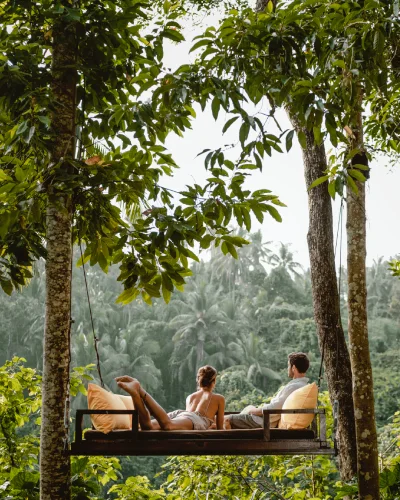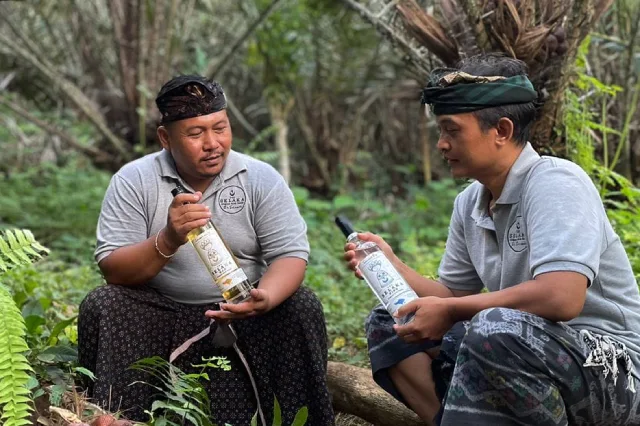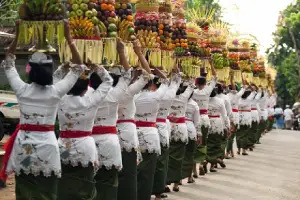Things to Do in Bali
UBUD GUIDE – All you need to know about Ubud
Ubud is known for…
- Relaxed atmosphere
- Cultural Relevance
- Nature: Rice terrace, waterfall, forests all around
- Dance shows & Museums
- Yoga, Body, Mind & Soul
- Health (Food, Spas, Spirituality)
- Great hub to explore the orther parts of Bali
How is Ubud in general?
Ubud is a major centre of the Balinese culture and local spirituality that has attracted artists and travelers for nearly a century. Even though the ever-increasing popularity means that Ubud can get as busy as Bali’s southern neighborhoods, particularyl during daytime, yet Ubud has kept its timeless charm and definitely needs to be in your Bali bucket list.
Ubud maintained to a large extend traditional culture and artisan beauty. It is still one of the best places to visit temples, see Balinese art, observe cultural dances and performances, and practice yoga and a healthy lifestyle. Ubud’s cooler climate and lush vegetation also make it ideal for an escape from the heat of Bali’s beaches. Just watch out for the mischievous monkeys that inhabit the forests surrounding Ubud.

Source: Wonderful Indonesia
Ubud is a place in Bali where people from all over the globe come to attend retreats, seminars and workshops focused on taking care of mind, body, and soul. It’s a place where since decades travelers have looked for more balance and well-being in their lives. Ubud is a magnet for spiritual seekers.
Ubud is an excellent location from which to explore Bali’s center and north, including its many surrounding temples, waterfalls, and rice terraces.
Many beautiful small shops, cafes, boutiques and since decades, Life is more calm here. Don’t forget to visit one of the traditional dance shows. Ubud is now also popular among digital nomads due to its amazing coffee shops, co-working spaces, and healthy food options. Climate is significantly cooler and it rains much more than at the coast.
#spiritual #art #temples #coolbreeze #nature #relaxed #digitalnomads #tours #shopping #monkeyforest #ubudmarket
Book your Hotel, Resort, Villa and Guest House in Ubud
Don’t Forget
Ubud – Guide & Insights
Seeing as Ubud runs as a cultural hub for creative and spiritual people, you’ll find many retreats to stay at for those on a journey. Even though the hotels and resorts are inland, and the beaches aren’t as easily accessible, forest and jungle are present instead. If you’re looking for tranquility surrounded by blissful nature, then the lush villas and bamboo huts available in this area will provide you just that with a private pool and hospitable service on hand.
Ubud has many guest houses run by friendly local families, some of which have welcomed travelers since decades, as well as a variety of elegant and well-priced mid-range hotels.
The mountainous countryside just outside Ubud is home to some breathtaking five-star hotels and luxurious serviced villas. Some of these amazing crown jewels of hospitality are up to 30min away from the center of Ubud nestled within nature and river valleys. Whether you are trying to stretch every penny or spend like there’s no tomorrow, you will be able to find a place in Ubud surrounded by forest and jungle to be one with nature.
Where to Stay in Ubud Book Hotels & VilasSome of Ubud’s traditional dishes have gained so much popularity that entire restaurants have been built around them. Members of the large expatriates’ community in Ubud have also opened restaurants serving food from around the world. Healthy foods are all the rage in Ubud; almost all restaurants have vegetarian, vegan and organic options available, as well as dishes for people with dietary restrictions.
Wine & DIne in UbudUbud has a growing nightlife, mostly centred on live music. Drinking and dancing are not uncommon, as most heavy partying happens on the west side of the island. However, you’ll find that Ubud offers a relaxed and quieter experience as nightlife here ends much earlier than in Kuta or Seminyak, compared to their younger counterparts. That doesn’t mean you won’t find fancy bars and lounges in the area to wind down for the night with a cocktail or two in hand.
Wine & DIneThe palace of Ubud’s royal family is in the centre of town and able to be visited. Just next door to it is a large traditional market selling goods of every kind. At the south of the Ubud centre is a monkey forest where a tribe of monkeys runs wild among moss-covered statues and shrines.(be cautious, they can be quite aggressive).
Also within Ubud are many museums showcasing the lives and works of local artists and expatriates who have settled there, some of which date back 50 years or more. Dances and performances are regularly held in several venues. Around Ubud are several amazing rice terraces, waterfalls and natural sites to explore – as well as many historical sites and temples. These can be visited in tours, either by car or bike.
The area around Ubud is ideal for hiking and biking, and whitewater rafting on mountain rivers is also an option. Walking around the town itself can be entertaining, preferably in the cooler and drier mornings and late afternoons. Many meditation and yoga classes are available, as are courses in Balinese dance and cooking. Ubud is home to regular festivals for authors, artists, musicians, and the spiritually inclined, and these can be great fun if they happen while you are visiting. Ubud also has fantastic spas and is a great place to pamper yourself with a traditional massage or herbal treatment.
Ubud is known to be well over 1,000 years old, and for much of that time, it has been a centre for monasteries and shrines. The royal families grew strong during Bali’s Majapahit era, and in the 20th century, they welcomed in Dutch colonialists, unlike the rulers of other parts of Bali. Between the 1930s and 1970s, Ubud began to attract artists, filmmakers, and musicians, many of whom settled there and made it their home, interacting with local artists and dancers and contributing to Bali’s cultural development. In the 1970s, Ubud began to become a popular tourist destination, and it has grown since then, always at an increasing rate. Today, it is a fully developed tourist centre but is still highly focused on spiritual principles.
History of Ubud
Ubud, located in the Gianyar Regency, is renowned as Bali’s cultural heart and a hub for traditional arts, spirituality, and wellness. Its historical significance goes far beyond its present status as a tourist hotspot, deeply rooted in Balinese culture and history.
Origins and Spiritual Foundations
Ubud’s spiritual history begins in the 8th century when the Javanese priest Rsi Markandya traveled to Bali. He meditated at the confluence of two rivers in Campuhan, a site considered highly auspicious in Balinese Hindu tradition. There, he established the Gunung Lebah Temple, which remains a major pilgrimage site  . The name Ubud derives from the word ubad, meaning “medicine,” reflecting its historical role as a center for medicinal plants and healing.
Royal Dynasties and Their Influence
In the late 19th century, Ubud became the seat of the Sukawati royal family, a powerful Balinese Kshatriya dynasty. Under the leadership of Cokorda Gede Agung Sukawati, the royal family played a crucial role in the region’s cultural development. The Sukawati lords were staunch supporters of the arts, commissioning works from local artisans and fostering an environment where traditional Balinese art, dance, and music could thrive. By aligning themselves with the Dutch colonial authorities in the early 20th century, they ensured that Ubud could focus on cultural and religious life, while the kingdom of Gianyar handled administrative duties .
European Influence and Artistic Renaissance
Ubud’s rise as a global cultural center accelerated in the early 20th century, particularly with the arrival of European artists such as Walter Spies and Rudolf Bonnet.
Walter Spies, a German painter, arrived in Ubud in 1927, invited by the Sukawati family. Spies was instrumental in blending traditional Balinese aesthetics with European modernism. His influence on Balinese art was profound; he helped formalize and elevate Balinese artistic styles, promoting them internationally through exhibitions and publications. Spies’ residence in Campuhan became a gathering place for artists, scholars, and travelers, fostering a vibrant artistic exchange .
Rudolf Bonnet, a Dutch artist, arrived in Bali in 1929 and further contributed to the artistic development of Ubud. Bonnet was particularly influential in promoting figurative art, with a focus on portraiture and everyday Balinese life. He, alongside Spies and the royal family, co-founded the Pita Maha artists’ cooperative in 1936. The cooperative played a key role in preserving traditional Balinese art while also supporting the creation of new works .
Pita Maha and the Legacy of Artistic Movements
The Pita Maha movement not only preserved Balinese art but also introduced it to the world through exhibitions and sales. The cooperative included both Balinese and foreign artists and became a crucial institution for fostering artistic growth in Ubud. Following World War II, Bonnet and Cokorda Gede Agung Sukawati established the Puri Lukisan Museum in 1957, Bali’s first museum dedicated to fine arts .
Post-Colonial Artistic Movements
Ubud’s artistic heritage continued to evolve after Indonesia’s independence. In the 1960s, the Young Artists Movement emerged, led by Arie Smit, a Dutch artist who had settled in Bali. Smit encouraged young Balinese painters to embrace more vibrant colors and less traditional themes, giving rise to a new generation of artists. This movement brought Balinese art into the contemporary era, while still maintaining its distinct cultural roots .
Modern Ubud
In the latter half of the 20th century, Ubud experienced a significant tourism boom, driven by its cultural and artistic allure. The town became a magnet for international travelers seeking spiritual and artistic experiences. Notable cultural institutions like the Neka Art Museum, Agung Rai Museum of Art (ARMA), and the Blanco Renaissance Museum now stand as testaments to the town’s enduring artistic legacy.
Today, Ubud continues to serve as a vital center for Balinese art and culture. Its streets are filled with galleries, traditional dance performances, and temples that reflect the town’s rich cultural history, making it a must-visit for travelers interested in the island’s artistic and spiritual heritage.
The center of Ubud is great for walks. But if you stay a bit outside of the center (see our map above) then you need some form of transportation.
Ubud’s local communities are very strict on managing transportation in their territories and have (someties violantly) pushed the online taxis like Grab and GoJek (hailing apps like Uber) out of Ubud. They don’t operate here, or are only allowed to drop guests when they come from outside of Ubud.
Many local taxi groups have an agreement with hotels, restaurants and tourist attractions, to cater guests exclusively. Prices are often not fixed, which can be a bit annoying since the drivers naturally want to get the highest fee, even for short distances. It’s fine to bargain.
Many hotels who are not located near the center of Ubud offer free shuttles to drop and pick up their guests in the center (near the palace or Ubud market) a few times a day. It’s just that the traffic can get quite heavy during the day.
Renting a scooter is a great idea; but only if you have experience riding two-wheelers. Don’t forget to arrange your International Driving License.
























